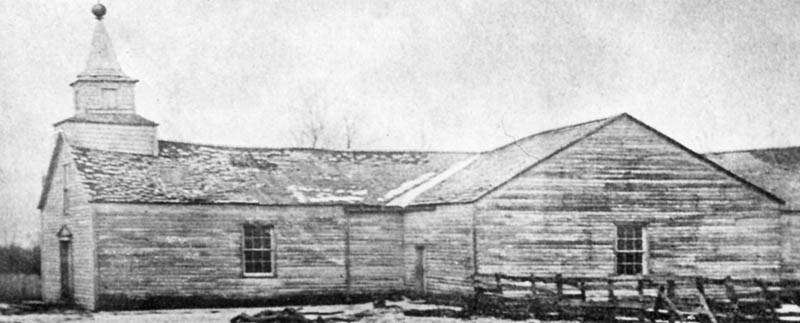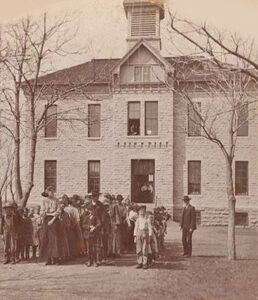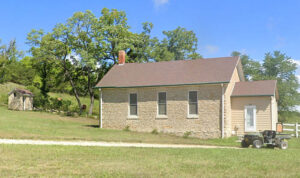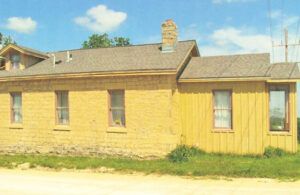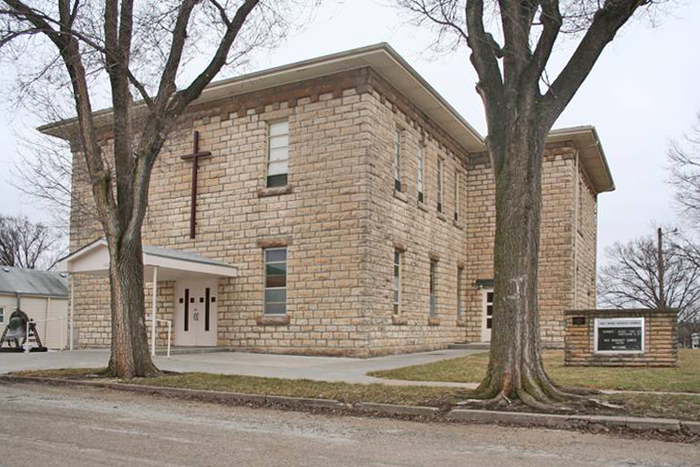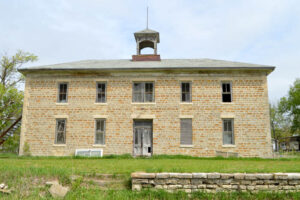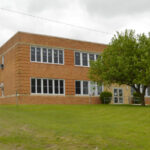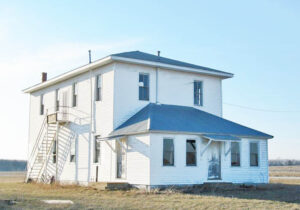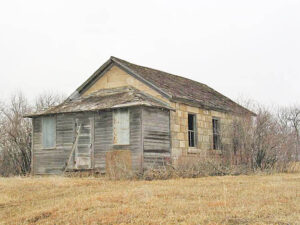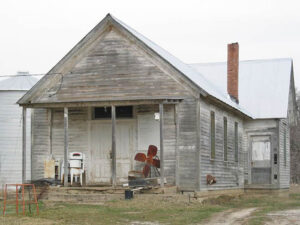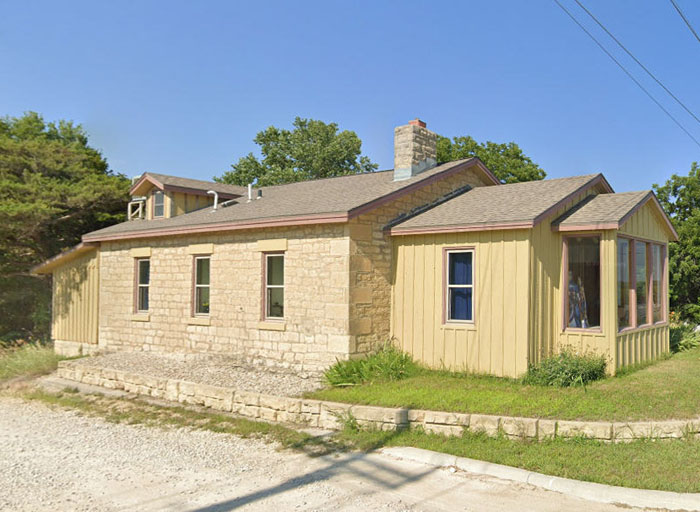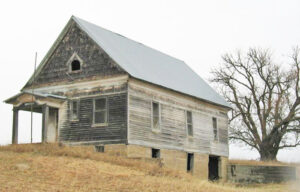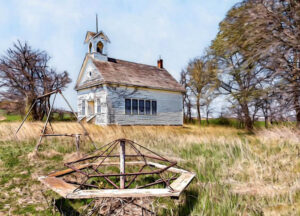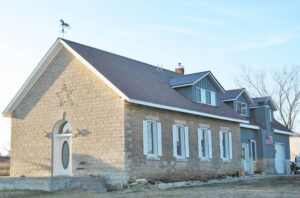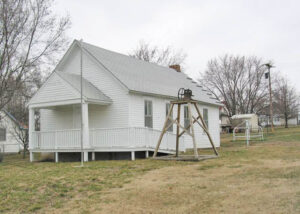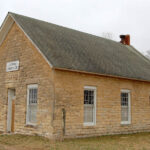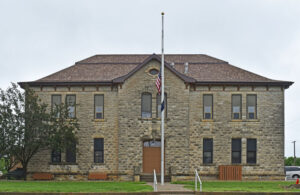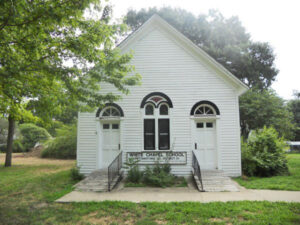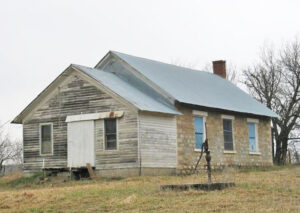The first white people to settle within Pottawatomie County were Catholic missionaries who went to St. Mary’s, Kansas, a few weeks before the Potawatomi Indians immigrated to their reservation, of which St. Mary’s was a central point.
The mission and a log house near it were built in 1848. The Indians contributed to the erection of the mission school, which occurred 15 years before the common schools.
On January 4, 1860, Samuel W. Greer, Territorial Superintendent of Public Instruction, submitted a report to the Legislature, in which Pottawatomie County was reported as having six organized school districts, five of which had employed teachers; $9 had been raised to build schoolhouses; $30 had been raised by private subscription for teachers’ wages. There were 182 persons of school age.
In 1876, 87 districts and 79 schoolhouses were valued at $13,126. Other educational establishments, including St. Mary’s College, under the care of the Jesuit fathers, an academy and parochial school for young ladies and a parochial school for boys, were also at St. Mary’s Mission.
J. S. Mitchell, the County Superintendent, in his report for 1882, stated: The children of school age are – males, 2,927; females, 2,765; total, 5,692. The number of school buildings is 98; the number of school rooms is 106. There are ninety-eight school districts. Four joint districts are with Nemaha, three with Jackson, and three with Riley. That year, the superintendent made 120 school visits and organized two school districts, and since October 1, 1881, there have been examinations of 203 teachers. The estimated value of the school property is $80,735. There were $8,505 of schoolhouse bonds issued during the year. The present bonded indebtedness is $17,455. The certificates granted were of first grade, seven; second, sixty-seven; third, fifty-seven. About 80% of the school children were enrolled during the year, while the average daily attendance was only 55% of the enrollment. Eight new school buildings were erected and finished during the year, and five new ones are in progress. The tax levy for all school purposes is 9.2 mills.
In 1910, the county had 120 organized school districts and several high schools. St. Mary’s College at St. Marys was one of the leading Catholic educational institutions in the West. There was also a Catholic parochial school there, an Evangelical school at Belvue, and St. Luke’s (a German Lutheran school) in Onaga.
Today, there are the following school districts.
Wamego USD 320 – Headquartered in Wamego, Kansas, the district includes the communities of Wamego, Belvue, Louisville, Wabaunsee, Zeandale, and nearby rural areas. It is mainly in Pottawatomie County, with portions in Riley and Wabaunsee counties. The school district operates the following schools:
Wamego High School in Wamego.
Wamego Middle School in Wamego.
Central Elementary School in Wamego.
West Elementary School in Wamego.
Kaw Valley USD 321 – Headquartered in St. Marys, Kansas, the district includes the communities of St. Marys, Delia, Emmett, Rossville, Willard, Saint Clere, and nearby rural areas. The school district operates the following schools:
St. Mary’s Jr/Sr High School
Rossville Jr/Sr High School
St. Mary’s Grade School
Rossville Grade School
Onaga USD 322 – Also known as Onaga-Havensville-Wheaton USD 322, the district is headquartered in Onaga, Kansas; it includes the communities of Onaga, Havensville, Wheaton, Duluth, Saint Clere, Neuchatel, and nearby rural areas. The school district operates the following schools in a conglomerate of connected buildings:
Onaga Senior High School
Onaga Junior High School
Onaga Grade School’
Rock Creek USD 323 – Headquartered in St. George, Kansas, the district includes the communities of St George, Westmoreland, Blaine, Flush, and nearby rural areas. The school district operates the following schools:
Rock Creek Junior/Senior High School in St George
St. George Elementary School in St. George
Westmoreland Elementary School in Westmoreland
The city of St. Marys also has the historic Saint Mary’s Academy and College, a religious school of the Society of St. Pius X. The first college at this location, St. Mary’s College, was founded by the Jesuits in 1848 as an Indian mission. The school is the site of the first cathedral west of the Missouri River and east of the Rocky Mountains. The 1851 “log cathedral” of Bishop John Baptist Miege, S.J., Apostolic Vicar of Kansas under Pope Pius IX, was known familiarly as “The Bishop East of the Rockies.”
When the Potawatomi Indians left the area, the Jesuits turned it into a boarding school for boys until it closed during the Great Depression. After 1931, the 465-acre plot hosted the divinity school of St. Louis University. With the movement of seminaries to the city after Vatican II, the land was sold, and the Jesuit divinity school returned to St. Louis in 1967.
In 1978, the Society of Saint Pius X acquired the property along with 12 significant buildings. The school is now incorporated in Kansas as The Society of Saint Pius X of Saint Mary’s, Inc. It has no ties with the previous St. Mary’s College. As of 2024, the Academy had an enrollment of over 900 students in K-12. The two-year college has expanded to a four-year bachelor’s program with an enrollment of 60 in a liberal arts curriculum. St. Mary’s does not have a seminary program.
Historic Schools
| Name | District | Years of Operation | Location & Information |
| Cedar Creek |
The old limestone Cedar Creek School, with a tin roof, has an enclosed frame entranceway and a stone outhouse in the back. It is located at 7000 Cedar Creek Road in the Manhattan, Kansas, area.
|
||
| District #1 | 1 | 1870-1957 |
This was the first public schoolhouse in the county. It served as a grade school (K-8) until 1957. In the late 1950s, it was remodeled into a residence. The one-story rectangular stone building, designed in the Vernacular style with a gable roof, is located at 8801 Junietta Road in the Swamp Angel vicinity. |
| Fairview | 56 | 1910-1956 |
This rectangular one-story wood building with a gable roof was built in 1910. It also served as a community center with box suppers, spelling bees, funerals, and church services held in the building. The shed addition on the south has metal siding, and the roof is made of corrugated metal. The original building had a bell tower and brick chimney, both gone today. There is an outhouse at the southwest corner of the building and playground equipment at the site. The old school is at the intersection of Lincoln and Fairview Roads. It is about 6.5 miles southeast of Onaga, Kansas. |
| Holy Cross School & Church | NA | 1907 |
This two-story limestone L-shaped Vernacular building was built in 1907 in Emmett, Kansas at the corner of Walker and 1st Streets.
|
| Havensville | ?? | 1882-?? |
This two-story stone Havensville Grade & High School was built in 1882. Built in the Vernacular style, it features a small, centered bell tower. It has been vacant since at least 1977. It is located at Barbara and Pottawatomie Streets in Havensville, Kansas.
|
| Havensville High School | ?? | 1937-2001 |
This two-story brick high school was built in 1937 after the original high school burned down in 1937. After consolidation, Havensville Rural High School students went to Onaga, and the building was used as an elementary school. The school closed in 2001 when elementary students were also moved to Onaga. Today, the Commercial Style building is used as a Meeting Hall. |
| Laclede Schoolhouse | 1900-?? |
This two-story vernacular style is a rectangular wooden frame building with a one-story enclosed front porch with a hip roof. It has two rooms upstairs, two rooms downstairs, and a kitchen. The school had two teachers. It was used as the Center Township Voting until recently. It is 1/4 mile west of Onaga Road on Pauling Run Road near Wamego, Kansas. |
|
| Louisville High School | ?? | ?? |
This old limestone high school and gymnasium on East Webster Street in Louisville, Kansas, are vacant today. |
| Pauling | ?? | Approximately a half-mile north of the Pauling Road and Adams Creek Road intersection | |
| Pleasant Ridge | 43 | 1880 |
The old Pleasant Ridge School is a one-story rectangular building with a gable roof, built of stone, wood, and brick in the vernacular style. It is located .8 miles south of Highway 16 on English Ridge Road near Onaga, Kansas.
|
| Pleasant Valley | 16 | 1871-1949. |
Pleasant Valley School District #16 was organized in 1863. This building was erected in 1871 and funded by $1200 in bonds approved by the district. It operated as a school until 1949. The one-story T-shaped wood-frame building was designed in the vernacular style and has a corrugated metal roof. It is located at the intersection of Onaga Road and Pleasant Valley Road. |
| Pottawatomie School District #1 | 1 | 1870-1957 |
This was the first public schoolhouse in the county, built in 1870. It served as a grade school (K-8) until 1957. In the late 1950s, it was remodeled into a residence. It is located at 8801 Junietta Road, in the Swamp Angel neighborhood near Manhattan. |
| Rolling Prairie | 57 | 1871-1948 |
Rolling Prairie School is a one-story rectangular wood-frame building designed in the vernacular Queen Anne style with a gable roof and wood columns. It has a stone basement and a recessed entry at the southwest corner, with a corrugated metal roof. In 1871, the west side of the Vienna School District decided to form its own district. James Taylor donated land, and they spent $500 on the new school. It was later moved to this site and used as a school until 1948, when it consolidated with Cloverleaf District #120. Today, the basement that is open to the East is used as a hay barn. It is located at Rolling Prairie Road and Godlove Road near Onaga, Kansas. |
| Sales | 1950s |
Closed in the 1950s. |
|
| Tannerville | 1896-1940s |
This one-story rectangular stone school was designed in the vernacular style with a corrugated metal gable roof and gabled dormers. It was converted to a residence in 2000. There is a garage addition with an apartment above in the rear. It was used for grades 1-8 until the 1940s. Afterward, it was used as a 4H clubhouse and community hall/dances through the 1950s. It is located at 20825 Tannerville Road near Wamego, Kansas. |
|
| Victory | 63 | 1891-1955 |
Victory District #63 was organized in 1871; this building was erected in 1891 for $500. It was moved to the southeast corner of Section 5 in 1907 and used as a school and meeting hall through 1955. This one-story rectangular wood frame building was designed in the vernacular style with a gable roof and a front porch. Vienna Township then purchased it to use as a voting hall. Later, it was moved to the Onaga Historical Society Complex, which is now used as a museum. The school is among several others at the museum complex. The school bell and playground equipment are east of the building. It is on the north side of the 300 block on East Second Street in Onaga, Kansas. |
| Wamego | 71 | 1885-?? |
Now called the Cottonwood Community Club, this old school building is located at Highway 99 and Wells Creek Road outside Wamego. |
| Westmoreland Elementary | 10 | 1898-1992 |
The former Westmoreland Grade School building is now the Pottawatomie County Courthouse Annex. It served as a school until 1992, when the elementary school was moved to a former high school. This two-story stone T-shaped building was designed in the Vernacular style with a hip roof, a gable dormer over the front entry, and a bracketed wood cornice. It is located at 207 N. 1st Street in Westmoreland, Kansas. |
| Wheaton | ?? | ??-1966 | After consolidating with the Onaga School District in 1966, the Wheaton School closed. Wheaton students participated on men’s and women’s basketball teams, a football team, and a baseball team. |
| White Chapel | 51 | 1882-?? |
The White Chapel one-room schoolhouse is a one-story wood-frame rectangular building built in the vernacular style with a gable roof and a brick chimney. It has arched transoms over the two front doors and an arched window in front. It was initially located on Camp Creek Road in Center Township. In 1984, it was moved to Wamego Museum’s Prairie Town Village on East 4th Street in Wamego, Kansas. |
| White Pigeon | 18 | 1896-1955 |
This rectangular one-story native stone building was designed in the vernacular style with a gable metal roof. Records indicate that White Pigeon was taught by Ed Toothaker in 1896 and operated as a school through 1955. In 1956, pupils were transported to Onaga Grade School, which is located on Rolling Prairie Road near Onaga, Kansas. |
©Kathy Alexander/Legends of Kansas, updated June 2025.
Also See:
One-Room, Country, & Historic Schools of Kansas
Pottawatomie County Photo Gallery
Sources:
Blackmar, Frank W.; Kansas: A Cyclopedia of State History, Vol I; Standard Publishing Company, Chicago, IL 1912.
Cutler, William G; History of Kansas; A. T. Andreas, Chicago, IL, 1883
A New Centennial History of Kansas,” Charles Tuttle, 1876
Wikipedia

